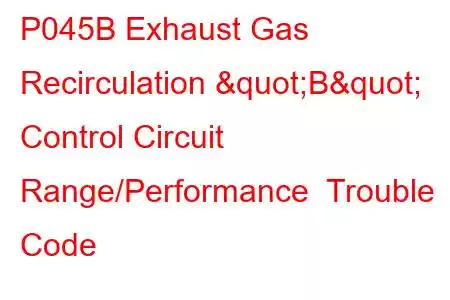P045B Exhaust Gas Recirculation B Control Circuit Range
OBD-II Trouble Code Technical Description
Exhaust Gas Recirculation "B" Control Circuit Range/Performance
What does that mean?
This diagnostic trouble code (DTC) is a generic powertrain code, which means that it applies to OBD-II equipped vehicles with an Exhaust Gas Recirculation system. Vehicle brands may include (but are not limited to) Land Rover, GMC, Chevrolet, Dodge, Chrysler, Ford, Toyota, Honda, etc. Although generic, the specific repair steps may vary depending on make/model.
The EGR (Exhaust Gas Recirculation) system's purpose is to redirect exhaust gas back into the cylinders. Since exhaust gas is inert, it displaces oxygen and fuel, thereby lowering cylinder temps, which, in turn, lowers oxides of nitrogen emissions. For that reason it needs to be carefully metered into the cylinders (via the EGR valve) so as not to adversely affect the engine's performance. (Too much EGR and the engine won't idle).
If you have a P045B, then the EGR valve is likely an electrically controlled EGR valve instead of a vacuum controlled EGR valve. Also, the valve will usually have a feedback system built into it that informs the PCM (Powertrain Control Module) what position the valve is in; open, closed, or somewhere in between. The PCM needs to know this to determine whether or not the valve is operating as needed. If the PCM determines that the valve should be operating, but the feedback circuit shows that the valve is not open, this code will set. Or if the PCM determines the valve should be closed but the feedback signal indicates that the valve is open, this code will set.
Refer to a vehicle specific repair manual to determine which is the "B" EGR circuit in your particular case.
Potential Symptoms
There may be no symptoms of a P045B trouble code other than the MIL (malfunction indicator lamp) or check engine light.
However, Exhaust Gas Recirculation systems are inherently problematic due to carbon buildup in the intake manifold, etc. This normal buildup can lodge in an EGR valve, holding it open when it should be closed. If this is the case, the engine may idle rough, or not at all. If the valve has failed and is NOT opening, then symptoms would be higher combustion temps and as a result, higher Nox emissions. But the latter symptoms aren't going to be noticeable to a driver.
Causes
Usually this code points to either carbon buildup or a bad EGR valve. However that doesn't rule out the following:
Open or short in the 5 Volt reference circuit Open or short in the ground circuit Open or short in the PCM controlled voltage circuit Bad PCM (less likely)Possible Solutions
If you encounter this trouble code, we encourage you to refer to a vehicle specific repair guide for your particular year, make, model and engine. The following information is more general in nature. Be sure to also check for TSBs (technical service bulletins) that may apply to your vehicle.
Using a scan tool command the EGR valve "B" to open while watching the actual EGR position (it will probably be labeled "desired EGR" or something similar). The actual EGR position should be very close to the "desired" EGR position. If it is, then the problem is likely intermittent. It may have been a lodged piece of carbon that has since dislodged, or it could be a bad EGR valve winding that intermittently opens or shorts as the valve temperature changes. If the EGR "desired" position is not close to the "actual" position, then unplug the EGR sensor. Check for a good 5 Volt reference voltage to the connector. If it doesn't show a reference voltage, repair an open or short in the 5 Volt reference circuit. If there is a 5 volt reference voltage, activate the EGR with the scanner, monitor the EGR ground circuit with a DVOM (Digital Volt/Ohm meter). It should indicate a good ground. If it doesn't then repair the ground circuit. If there is a good ground, then check the control circuit. It should indicate voltage that varies according to the percentage that the EGR is open. As it's open more, the voltage should increase accordingly. If it does, then replace the EGR valve. If the voltage doesn't increase incrementally, then repair open or short in EGR control circuit.Read: 44


